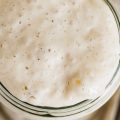Achieving soft sourdough bread can be a challenge, I’m not going to lie. Often times your long baking process leads to dense, chewy loaves – and much frustration. Let me share with you some proven techniques to help you create softer, more delicate sourdough. I’ll teach you today how to make sourdough more soft!
![How To Make Sourdough More Soft [Full Guide] 1 How to make sourdough more soft [full guide]](https://www.mydailysourdoughbread.com/wp-content/uploads/2024/05/How-to-Make-Sourdough-More-Soft-Full-Guide-840x473.jpg)
Table of Contents
- What Ingredients Influence Softness?
- Kneading Techniques for Softer Sourdough
- Fermentation Time
- Baking Conditions
- Cooling and Storage
- Addressing Common Issues You Might Encounter
- Advanced Tips for Soft Sourdough
- Soft, Fluffy Loaves!
- How to Make Sourdough More Soft: FAQs
What Ingredients Influence Softness?
Ingredients you choose definitely play an important role in making or breaking the texture of your bread.
Flour Types: Whole Wheat vs. White
While whole wheat flour is packed with nutrients and fiber, it tends to produce a denser, more robust crumb. On the other hand, white flour, especially high-protein bread flour, can yield a softer, more tender texture.
If you’re aiming for a pillowy soft sourdough, consider using a higher proportion of white flour or even experimenting with low-protein flours like pastry flour. However, keep in mind that the lower the protein content, the less structure your bread will have, so find a balance that works for you.
Hydration Levels: The Secret to Softness
One of the most significant factors in creating a soft sourdough is the hydration level of your dough. Hydration refers to the ratio of water to flour in your recipe. A higher hydration dough, typically around 75% or more, will yield a softer, more open crumb.
High-hydration doughs can be trickier to handle, as they tend to be stickier and more delicate. But with practice and the right techniques, you’ll be rewarded with a loaf that’s soft, moist, and irresistible.
To increase the hydration of your dough, start by adding a little more water than your recipe calls for. As you mix, adjust the flour or water as needed to achieve a dough that’s tacky but not overly sticky. Remember, wetter doughs require a gentler touch and may need more time to proof and develop gluten strength.
Kneading Techniques for Softer Sourdough
Kneading helps develop the ideal texture you want for your sourdough bread. It’s because during this process, gluten formation occurs, giving your bread its structure and crumb.
Hand Kneading vs. Mixer
When it comes to kneading, you have two options: hand kneading or using a stand mixer. Hand kneading is a traditional method that allows you to get a feel for the dough and adjust the consistency as needed. It’s a great way to connect with your bread and develop a deeper understanding of the process.
However, if you’re short on time or dealing with a high-hydration dough, a stand mixer can be a lifesaver. It does the hard work for you, allowing you to multitask and streamline your baking process. Just be careful not to over-knead, as this can lead to a tough, dense loaf.
Developing Gluten Strength
Kneading is all about developing gluten strength. As you knead, the gluten strands stretch and align, creating a strong network that traps gas bubbles and allows your bread to rise.
To develop gluten strength, aim for a kneading time of around 10-15 minutes by hand or 5-7 minutes in a stand mixer. You’ll know your dough is ready when it becomes smooth, elastic, and passes the windowpane test (a small piece of dough can be stretched thin enough to see light through without tearing).
Kneading Tips for Softer Sourdough
- Use a gentler touch: Instead of aggressively punching down the dough, use a folding motion to incorporate the ingredients and develop gluten strength.
- Don’t over-knead: Over-kneading can lead to a tight, tough crumb. Stop kneading as soon as your dough passes the windowpane test.
- Let the dough rest: After kneading, give your dough a chance to relax and let the gluten settle. This will make it easier to shape and result in a softer texture.
Fermentation Time
Short vs. Long Fermentation
While a shorter fermentation time can yield a softer crumb, a longer fermentation allows for more complex flavors to develop.
When you opt for a short fermentation, typically around 4-6 hours, the yeast activity is more rapid, leading to a quicker rise in the dough. This faster fermentation process results in a softer texture, as the gluten network hasn’t had as much time to develop and strengthen.
On the flip side, a longer fermentation, often overnight or even up to 24 hours, allows the dough to rise slowly and steadily. During this extended fermentation, the yeast fermentation progresses at a more leisurely pace, giving the gluten more time to develop. This can lead to a slightly firmer crumb structure, but with the benefit of enhanced flavor complexity.
Finding the Sweet Spot
To achieve a soft sourdough while still enjoying the depth of flavor that comes with fermentation, experiment with finding the perfect balance for your taste preferences. You might start with a shorter bulk fermentation of around 4 hours, followed by an overnight rise in the fridge. This combination allows for some flavor development without compromising too much on softness.
Another approach is to use a higher proportion of starter in your recipe. A larger amount of active starter will speed up the fermentation process, allowing you to achieve a soft texture even with a shorter fermentation time.
Baking Conditions
The Power of Steam
One of the most effective ways to achieve a soft, tender crumb is by introducing steam during the baking process. When you create a steamy environment in your oven, it prevents the crust from setting too quickly, allowing your bread to expand and develop a beautiful, airy texture.
To generate steam, try placing a metal tray on the bottom rack of your oven and preheating it along with your baking stone or Dutch oven. When you’re ready to bake, carefully pour a cup of hot water into the tray, creating a burst of steam. This moisture will help keep the crust soft and pliable, giving your bread room to rise.
Temperature Matters
Higher temperatures, around 450-500°F (230-260°C), will result in a crispier crust and a denser crumb. For a softer loaf, try lowering the temperature to around 400-425°F (200-220°C).
A lower temperature allows the bread to bake more evenly, preventing the crust from hardening too quickly. This slower baking process gives the dough more time to expand and develop a light, fluffy texture.
Finding the Right Baking Time
Baking time is another factor that can impact softness. While it’s tempting to pull your loaf out of the oven as soon as it looks golden brown, a slightly longer bake can actually lead to a softer texture.
Aim for a baking time of around 35-45 minutes, depending on the size of your loaf. This extended time allows the moisture in the dough to evaporate slowly, creating a tender crumb and a thin, crisp crust.
Cooling and Storage
Let It Cool Completely
Once your sourdough loaf emerges from the oven, it’s tempting to slice into it right away. But hold your horses! Allowing your bread to cool completely on a wire rack is crucial for achieving the perfect texture.
As your loaf cools, the crumb structure sets and the moisture redistributes throughout the bread. Cutting into it too soon can result in a gummy, undercooked texture. Patience is key here – let your loaf rest for at least an hour, or until it’s cool to the touch.
Storing Your Sourdough
Did you know that proper storage is helps keep your sourdough soft and fresh for as long as possible?
If you plan on consuming your bread within a day or two, storing it at room temperature in a breathable container, like a paper bag or a bread box, is your best bet. This allows the crust to remain crisp while preventing the bread from drying out too quickly.
For longer storage, you can freeze your sourdough. Slice it first, then wrap the slices tightly in plastic wrap or aluminum foil. Place the wrapped slices in a freezer-safe container or bag, and store them in the freezer for up to three months. When you’re ready to enjoy a slice, simply thaw it at room temperature or pop it in the toaster for a quick reheat.
![How To Make Sourdough More Soft [Full Guide] 2 How to make sourdough more soft [full guide]](https://www.mydailysourdoughbread.com/wp-content/uploads/2024/05/How-to-Make-Sourdough-More-Soft-Full-Guide-3-840x473.jpg)
Addressing Common Issues You Might Encounter
Even with the best efforts and techniques, sometimes our sourdough loaves don’t turn out quite as soft and fluffy as we’d like. Let’s take a look at some common texture issues and how to fix them.
Dough Too Dense
If your sourdough is coming out dense and heavy, there could be a few culprits at play. One possible issue is that your starter isn’t active enough. Make sure you’re feeding your starter regularly and that it’s doubling in size before you use it in your dough.
Another potential problem is overworking the dough. While kneading is important for developing gluten, too much handling can lead to a tough, dense crumb. Be gentle with your dough and stop kneading as soon as it becomes smooth and elastic.
Bread Too Chewy
Chewy sourdough can be a result of several factors. One common issue is not letting the dough rise long enough. Make sure you’re giving your dough plenty of time to proof, both during the bulk fermentation and the final rise. A properly proofed dough will have a light, airy texture.
Another possible culprit is baking at too low of a temperature. If your oven isn’t hot enough, the crust will set before the bread has a chance to fully expand, resulting in a chewy texture. Aim for a baking temperature of at least 400°F (200°C) for the best results
Troubleshooting Tips
If you’re consistently running into texture issues, try these troubleshooting tips:
- Write down the details of each bake, including the ingredients, techniques, and results. This will help you identify patterns and pinpoint areas for improvement.
- Different flours have different protein contents, which can affect the texture of your bread. Try mixing in some lower-protein flours, like pastry flour or even a bit of rye, to soften the crumb.
- If your dough is too stiff and dense, try increasing the hydration slightly. A wetter dough will yield a softer, more open crumb.
Advanced Tips for Soft Sourdough
Tangzhong Method
The tangzhong method is a game-changer. This technique, which originated in Japan, involves cooking a portion of the flour and water into a thick paste before adding it to the dough. The result? A loaf with unparalleled softness and a longer shelf life.
Simply mix equal parts flour and water (by weight) in a saucepan and cook over low heat, stirring constantly, until the mixture thickens into a pudding-like consistency. Let it cool, then add it to your dough during the mixing stage. You’ll be amazed at how this small step can transform your bread’s texture.
Autolyse for Better Gluten Development
Another technique that can lead to softer sourdough is autolyse. This fancy-sounding term simply means mixing the flour and water and letting the dough rest before adding the salt and starter. During this resting period, the flour absorbs the water, and the gluten begins to develop on its own.
Autolyse can help make your dough easier to handle, improve its elasticity, and ultimately lead to a softer crumb. To try it out, mix your flour and water until no dry bits remain, then cover the bowl and let the dough rest for 30-60 minutes. After the rest, add your salt and starter, and proceed with kneading as usual. You’ll notice a difference in the dough’s texture and the finished bread’s softness.
Experiment with Different Flours
While bread flour is a staple in most sourdough recipes, don’t be afraid to branch out and experiment with other types of flour. Incorporating a portion of lower-protein flours, like pastry flour or even all-purpose flour, can help create a softer crumb.
You can also try adding a bit of spelt, einkorn, or kamut flour to your dough. These ancient grains have a naturally lower gluten content, which can contribute to a more tender texture. Start by substituting a small amount (10-20%) of your bread flour with one of these alternative flours, and see how it affects your loaf’s softness.
Soft, Fluffy Loaves!
Crafting a soft sourdough loaf requires a few know-hows, but with practice, you’ll soon be rewarded with a soft, irresistible sourdough that’s well worth the effort!
How to Make Sourdough More Soft: FAQs
How do I make my sourdough softer?
To make your sourdough softer, try increasing the hydration of your dough, using a higher proportion of wheat flour, and incorporating techniques like autolyse and stretch and fold. Additionally, consider using a Dutch oven to create steam during baking, which helps develop a softer crust. Experiment with these methods to find the perfect balance for your desired texture.
How do you soften sourdough bread?
To soften sourdough bread, you can try a few methods. Wrapping the bread in a damp towel and reheating it in the oven can help reintroduce moisture. Alternatively, place the bread in a sealed plastic bag overnight, allowing the moisture to redistribute. For a quicker solution, microwave the bread with a glass of water to create steam and soften the crust.
What to do if sourdough is too stiff?
If your sourdough is too stiff, it may be due to insufficient hydration or overworking the dough. To remedy this, try increasing the water content in your recipe and gently folding the dough instead of kneading it aggressively. Allow the dough to rest and relax between folds to promote gluten development and elasticity. These adjustments should result in a softer, more pliable dough.
Why is my sourdough not soft?
Your sourdough may not be soft due to several reasons, such as low hydration, overproofing, or insufficient steam during baking. Ensure you’re using a recipe with adequate water content and avoid letting the dough proof for too long. Create steam in your oven by using a Dutch oven or placing a tray of boiling water inside during baking to promote a softer crust.






